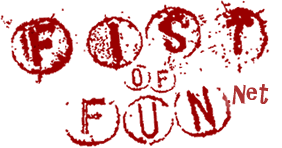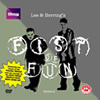Press Archives
Reference Articles
LEE & HERRING MUSIC SHOW - By Radio Haha
Radio 1 - Series 1 1994 (7 programmes), Series 2 1995 (6 programmes), Series 3 1995 (6 programmes) & Four compilations of Series 3 material, 1996
This programme was, along with The Chris Morris Music Show, one of the most successful results of Radio 1’s move away from half-hour comedy shows and towards hour-long slots mixing comedy and music. Compared to its predecessor, Lee and Herring’s Fist Of Fun (recorded live at student venues), it had a distinctly relaxed feel: liberated from the demands of the live audience, Richard Herring and Stewart Lee were free to do what they do best: ramble on at each other for minutes on end. Technically the show consisted of a mixture of sketches and music tracks linked by in-Studio chat.
The music was used to extremely good effect: as Lee and Herring never tired of pointing out, the show was produced by the Light Entertainment department and they were therefore obliged to bring their own records in. Lee, who describes himself as “an obsessive music fan since the age of eleven”, clearly relished the opportunity to give listeners a quick trip around the dark recesses of his absurdly voluminous record collection, and the innocuous chart hits woven through most other R1 comedies of the period were eschewed in favour of a dazzlingly diverse selection, encompassing everything from Scott Walker to Jilted John, via William Shatner’s startling cover of Lucy In The Sky With Diamonds.
A dedicated musical eclectic would have found reason enough to tune in on this count alone. The show’s defining feature, however, was the cheery Studio banter. The distinctive stage personalities usually adopted by Lee (self-assured, world-weary cynic) and Herring (cheerful, immature idiot) are based loosely on their real-life attitudes and personalities, and it was often difficult to detect just how far into or out of character they were at any point. When not arguing about the music, they would earnestly introduce features of quite staggering pointlessness (notably the poll to determine “the nation’s favourite chew bar” and a competition to find the nation’s dullest tourist attraction).
Because of the format, and the relatively large number of broadcast hours, it was this show rather than any of its predecessors which clearly displayed the principles of its stars’ highly theoretical brand of comedy. Lee and Herring once declared that their ultimate aim was “to be treated like gods”, and there is a definite cultish aspect to their comedy.
So, while both performers are highly competent writers of conventional comedy (hence Lee’s work as a script editor on other comedians’ shows), most of their material ultimately refers back to ideas which have already been laid down, and which can only be picked out by the devotee: in place of the running gag, the running sketch-structure. One favourite ploy, for instance, is to take a fairly cheesy idea gag or a play on words, and deliberately and protractedly overwork it until it collapses under its own weight (as in the following sample from a collection of lame sit-com titles: “The Bent Coppers, which is about two policemen, one is gay and the other one’s corrupt, and they both suffer from curvature of the spine… and they’re both made of copper”).
In-jokes, especially, have always been an integral part, rather than an afterthought: just about every character name the duo have ever used (from On The Hour onwards) is taken from a real-life acquaintance. Like the prophets of any major religion, Lee and Herring laid down various rules and principles: these ranged from actual commandments addressed to the listener (the most important of which, apparently, was “Leap nimbly!”), to theoretical ideas which apparently governed the sketches and features, including "the celebration of mediocrity" (based on the principle that, although the good were well rewarded in society and the evil received their due punishment, not enough was being done to express mild appreciation for those whose actions were just more-or-less adequate). Just as in previous series, though, their genuine intellectualism was directed towards reassuringly pointless targets.
Richard and Stewart’s regular co-stars were Peter Baynham, reprising his role as the Balham non-viveur from the previous series (now renamed simply ‘Peter’ to avoid confusion with Baynham himself) and Kevin Eldon, usually in the guise of the disturbed hobby enthusiast Simon Quinlank, who made his first-ever apperance in the first series.
Series One also featured a regular internet feature (not overtly sarcastic, but dwelling on the weirder side of net life) from Danny O’Brien, a comedian who had recently devised a one-man show on the subject. Also appearing at different points over the three series were various familiar faces: Ronnie Ancona, Rebecca Front, Alistair McGowan, Ben Moor, Sally Phillips and a number of others, all of whom would continue to work with Lee and Herring in the TV projects which followed.
Lee and Herring is also notable as the show which created a monster, in the shape of the duo’s unique and complex relationship with their fans. Series One brought the first trickle of letters (not an unusual phenomenon in DJ-driven radio), which the presenters began responding to on air: apparently bemused by, but pleased with, the time and trouble their listeners were taking, they made a feature of exhorting people to “send stuff in” along various themes, usually tied in to the terse phone-in features which were also a feature of the show. The audience was duly forthcoming with the requested arcane items (drawings of celebrities’ heads grafted onto insects’ bodies, to give but one example), and the phenomenon began to feed off itself as some of the letters prompted further comic areas to be explored.
By the end of Series Two, Lee and Herring were openly flaunting the power of what they dubbed “the child army”, suggesting quite specific displays of surreal collective action (most notably the innundation of an innocuous middle-aged local radio presenter with requests for signed photos from all over the country); by this point they were working on a television series, which they attempted to publicise by getting fans to place adverts in newsagents’ windows.
This first TV series, taking the Fist Of Fun title of the original Radio 1 show, had a much larger cast but retained the same central group of performers (and, incidentally, elevated Simon Quinlank and Peter-from-Balham to the status of cultural icons). It was closer in style and presentation to its half-hour namesake than to the more recent, audience-free show, although for source material it drew as much on Lee and Herring as any of the earlier projects.
In fact, the duo were keen to keep the radio show going, principally because of the opportunity it provided to try out new ideas, but also because of the freedom its format provided.
Series Three went out at the end of 1995, followed by a second TV series of Fist Of Fun, which suffered in comparison to the first, owing to rushed production schedules.
A while later, Lee and Herring actually offered to develop a fourth series of the radio show; incredibly, given their large youth fanbase and established television credentials, they were actually turned down by Radio 1, which had, for reasons best known to itself, abandoned comedy and all other features-based programming early in 1997. The compilation shows of 1996 (which were created without the stars’ involvement) thus signalled the end of Lee and Herring’s remarkably prolific five-year radio presence, although they returned to television in 1998 with a new show entitled This Morning With Richard Not Judy.

